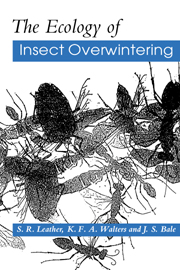2 - The overwintering locale – suitability and selection
Published online by Cambridge University Press: 16 September 2009
Summary
Introduction
Overwintering insects can be exposed to extreme physical conditions and the choice of the site in which they spend the winter is often critical to their survival. By locating a suitable overwintering site before the onset of harsh conditions, insects can mediate the adverse effects of low temperatures, rapidly changing temperatures, the chilling effect of wind, desiccation, lack of oxygen in aquatic environments and other similar hazards.
The differences in suitability, both between and within winter habitats can best be understood by considering those factors affecting the conditions experienced in a particular habitat. Clearly, the general conditions that have to be contended with, depend on the regional climate, which is determined partly by latitude, partly by altitude and partly by proximity to the seas, lakes and mountains. These general conditions are modified by local effects, such as inclination and aspects of slopes, vegetation, the nature of the ground surface and snow cover (Flohn 1969).
Temperature, of both macro- and microhabitats, is a useful factor with which to compare insect overwintering sites (Danks 1978) and will be used to illustrate how both regional climate and local conditions affect the suitability of sites for winter survival of insects.
The winter habitat – regional climate
Climate on a regional scale is partly determined by continental position. Lower winter temperatures generally occur in the centre of large land masses, well away from large bodies of water and less severe winter conditions are found in areas nearer the sea.
- Type
- Chapter
- Information
- The Ecology of Insect Overwintering , pp. 5 - 24Publisher: Cambridge University PressPrint publication year: 1993



